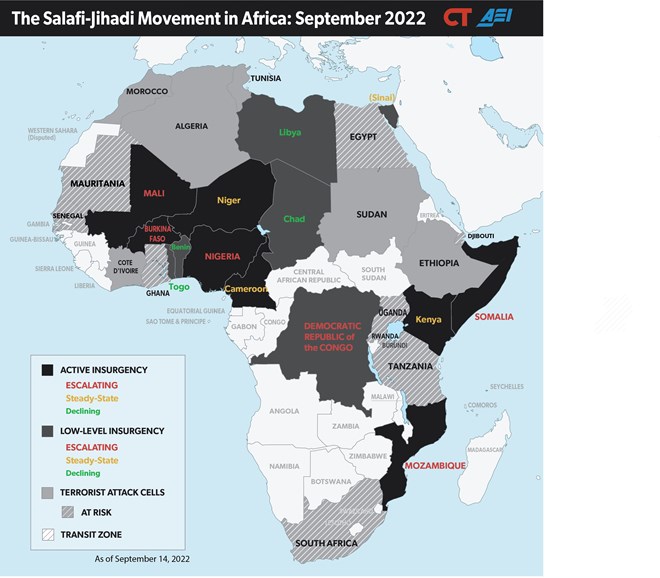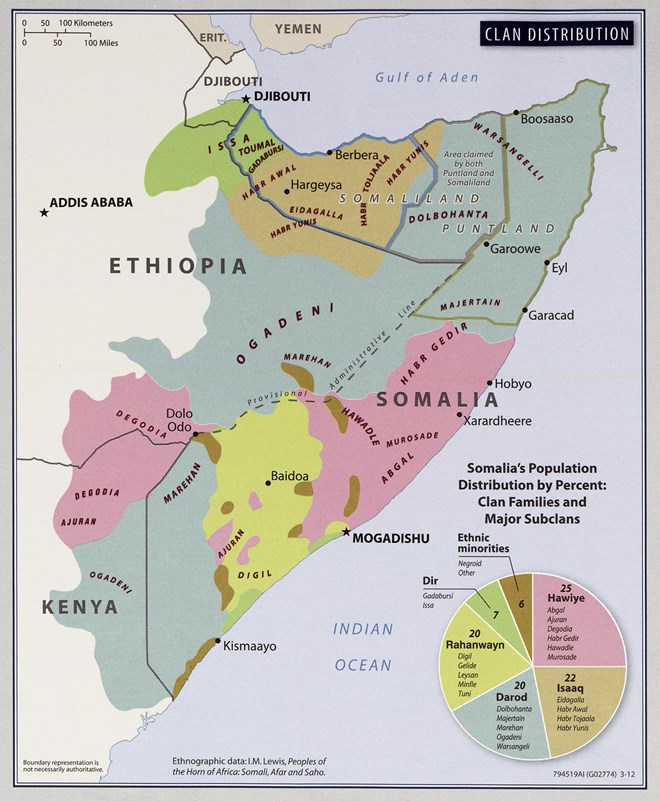
Saturday September 17, 2022
Key Takeaway: Local tribes in central Somalia are increasingly mobilizing against al Shabaab. Several Hawiye subclans in central and south-central Somalia have mobilized local militias to fight al Shabaab after militants ambushed a humanitarian aid convoy on September 2. The Somali government may also attempt to reconcile with the Sufi militia Ahlu Sunna wa al Jama’a (ASWJ) to bring the group into the counter–al Shabaab fight. Al Shabaab will likely accept losses in central Somalia in the short term. Defeating al Shabaab in central Somalia in the long term will depend on local and federal Somali authorities’ ability to deliver tangible and sustained improvements in governance and security.
Figure 1. The Salafi-Jihadi Movement in Africa: September 2022

Source: Emily Estelle and Kathryn Tyson.
Clan militias have played a crucial role in supporting the Somali Federal Government’s summer offensive in central Somalia from its outset. The Somali Federal Government (SFG) has waged an offensive against al Shabaab in central Somalia’s Hiraan region for most of the summer. Local Hawadle subclan militias, known as Ma’awisley, helped spur this offensive by attacking* an al Shabaab base on June 1. The Hawadle leaders claimed the attack was revenge for al Shabaab assassinating* a Hawadle elder on May 27. Clan members said* they never received a satisfactory explanation from al Shabaab, which accused the elder of apostasy for participating in Somali elections. The clan said the elder was a “clean Muslim man” and denied he participated in elections. Somali security forces and Hawadle militias went on to clear al Shabaab from at least 23 villages between June and August and claim to have killed at least 100 al Shabaab militants.
Figure 2. Somali Forces Wage Central Somalia Offensive: August 2022
Note: Somali National Army is abbreviated as “SNA.” For map definitions and an interactive map, click here.

Source: Author
The Hawadle are part of the majority Hawiye clan in central Somalia. The Hawiye consists of several subclans distributed across the regions and districts of central Somalia. Clans play a crucial role in Somali politics. Subclan rivalries drive disputes within individual federal member states (FMS), while clan rivalries cause conflict between the SFG and FMS and within the SFG itself. Al Shabaab also strategically uses clan connections to recruit members and arrange favorable agreements in areas it does not outright govern.
Figure 3. Somalia Clan Distribution

Source: Ioan Myrddin Lewis, Peoples of the Horn of Africa (Somali Afar and Saho) (London, UK: Routledge, 2019).
Al Shabaab initiated an escalatory cycle with the Hawadle militias by targeting Hawadle villagers. Al Shabaab destroyed* water wells and torched homes in several Hawadle villages on August 8. The attacks happened after a relative lull in the anti–al Shabaab offensive throughout much of July and helped spark a renewed urgency from Somali forces and clan militias. Hawadle militias and security forces increased joint* operations* after the attack and cleared at least 17 villages in the Hiraan region in the rest of August. The attacks were also an opportunity for the Somali government to gain local support by organizing humanitarian projects* and local government structures* in affected villages.
Al Shabaab responded to the increased pressure by increasing violence. Al Shabaab fighters ambushed a civilian-operated humanitarian aid convoy overnight on September 2. The attackers killed 21 civilians and destroyed nine trucks. Al Shabaab claimed* that the attack targeted local militia forces, which Somali officials denied. Al Shabaab also threatened* on September 4 to target any clan cooperating with the government, indicating it seeks to make an example of the Hawadle.
The September 2 attack mobilized community-level action against al Shabaab. Hawadle militias continued working with SFG forces to secure more areas of the Hiraan region in the aftermath of the attack, on September 5* and 9.* An unverified video posted on social media on September 5 shows villagers publicly prosecuting a captured al Shabaab militant in an unspecified location in the Hiraan region. Somali government-linked sources also posted pictures of women donating food and milk for troops in Beledweyne.
The September 2 attack also encouraged the Abgal subclan to mobilize against al Shabaab. The leader of the Abgal clan militia promised to cut off and destroy al Shabaab while sending his condolences to the Hawadle on September 10. The Abgal are the dominant Hawiye subclan in the Middle Shabelle region and southern Galgudud and Mudug regions (see Figure 3).[1] SNA and likely Abgal militia forces cleared* al Shabaab from areas near the border of the Hiraan and Middle Shabelle regions on September 12. The operation is the first reported instance of local militias in south-central Somalia participating in counterterrorism activities in 2022. Unverified social media posts also say Abgal and SNA forces attacked al Shabaab militants near the long-time al Shabaab stronghold of Harardhere in southern Mudug region on September 11.
Figure 4. Somali Forces Wage Central Somalia Offensive: September 2022
Note: For map definitions and an area of operations interactive map, click here.

Source: Author.
Al Shabaab attacks on civilians, including the September 2 humanitarian convoy attack, prompted the Habir Gadir, another major Hawiye subclan, to mobilize against al Shabaab. The Habir Gadir are the majority subclan in northern and central Galmudug and Mudug regions. Twitter users and Somali government-affiliated news sites have posted pictures and videos showing Habir Gadir mobilization since at least September 5. Al Shabaab targeted Habir Gadir villages less than 25 miles southwest of Bahdo village in northern Galgudud region on September 1* and 5.*
SNA and Galmudug State forces arrived* in Bahdo on September 11 to train and support locals who had “taken up arms.” The local fighters in Bahdo are already battle-tested, as they helped repel* a large al Shabaab suicide raid in June 2022. The mobilization of the Abgal and Habir Gedir alongside the Hawadle would put much of the Hawiye clan—and thus central Somalia—in open war with al Shabaab.
President Hassan Sheikh Mohamud may attempt to generate additional forces by convincing the Sufi militia ASWJ to join the fight in central Somalia. Former President Mohamud Abdullahi Mohamud (known as Farmaajo) exacerbated tensions between the Galmudug State government and ASWJ in 2020 when he allegedly rigged* state elections to install a political ally as president. The controversy effectively destroyed a 2017 power-sharing agreement and undermined ASWJ’s political power, leading to clashes* between ASWJ and Somali federal and state security forces in October 2021. ASWJ eventually withdrew* to northern Galgudud region at the end of October 2021 and has remained in that area.
ASWJ and President Mohamud have signaled their willingness to negotiate since Mohamud took office in May 2022. ASWJ leadership